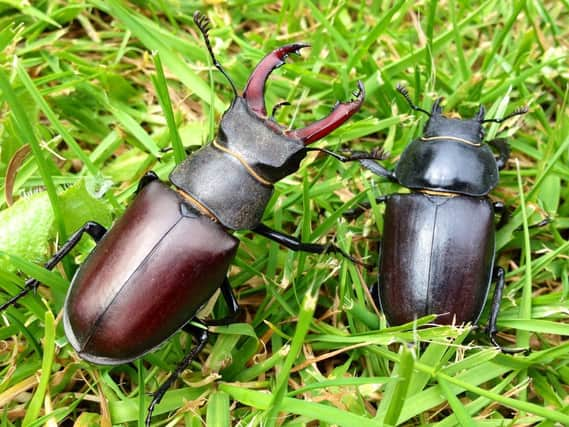Record spectacular stag beetles in Sussex this summer


Stag beetles were once widespread but due to habitat loss they’re now declining and have even become extinct in some parts of Britain and Western Europe. To prevent that from further happening PTES is calling for nature lovers, families, and individuals to help this summer by recording all sightings of male and female stag beetles, and their larvae (large, white grubs), online at: ptes.org/gsh
Stag beetles are easy to spot – they’re the UK’s largest land beetles and the males are instantly recognisable with their antler like jaws. From late May into July these iconic insects emerge from the ground in search of mates, and are usually spotted flying around gardens, parks and allotments on warm summer evenings. They can also be seen on walls and warm tarmac surfaces in urban areas, and in other green spaces too such as woodland edges, hedgerows and traditional orchards.
Advertisement
Hide AdAdvertisement
Hide AdLaura Bower, Conservation Officer at PTES says: “Last year almost 10,000 sightings were recorded by thousands of volunteers, giving us a real insight into where their range is, which is crucial for the species’ long-term survival. More help is always needed though, so whether you’re out in the garden, dog walking in a local park, on the school run or even walking to the pub, keep your eyes peeled for these beautiful beetles and tell us about any you see. You don’t need to be a beetle expert or have taken part before, as PTES has a free ‘beetle ID’ guide to help anyone new to the survey to help them tell the differences between stag beetles and other insects.”
Last year 9,334 stag beetle sightings were recorded via PTES’ Great Stag Hunt, with the highest numbers spotted in Hampshire (2,115 sightings), Greater London (1,781), Surrey (1,277), Berkshire (876) and Dorset (754). PTES is keen to hear from people in these areas this year, as well as other parts of Britain, and in particular, in counties on the edge of their range too, including Norfolk, Cheshire, Bedfordshire, Somerset, Lincolnshire, Northamptonshire and Shropshire.
Stag beetles usually prefer warm areas with lower annual rainfall and light soils, and as a result are widespread in southern England (excluding the North and South Downs, where the soil is chalky). There are also hotspots in the Severn Valley and in coastal parts of the southwest, but last year PTES received its first ever record of a stag beetle in the Lake District.
Laura adds: “This record from a woodland in Cumbria was really surprising, as we weren’t previously aware that stag beetles were in this part of the country. We now really need anyone in the Keswick area where this stag beetle was spotted to find out if that beetle is part of a wider population or if it was somehow transported there by accident.”
Advertisement
Hide AdAdvertisement
Hide AdThere are other ways to help stag beetles too. Those who regularly see stag beetles can join an additional ‘Stag Beetle Count’ survey which enables PTES to understand how population numbers might be changing year on year. This extra survey only requires volunteers to walk along a local transect looking for stag beetles for 30 minutes, six times over June or July, on warm sunny days.
Volunteer Gemma Alford, who took part in this extra survey last year, said: “I’ve enjoyed getting out looking for stag beetles during my transect walks, often accompanied by one of my children or my husband. It’s always exciting to spot a stag beetle and we’ve had other magical moments too, including observing noctule bats hunting around trees.”
Another great way to help stag beetles is to build a log pile or pyramid in your own garden. Simply keep any logs, tree stumps, fallen branches or old firewood and bury them upright in soil. This provides a vital food source for larvae (who feed on deadwood) as well as offering shelter and a place for female stag beetles to lay their eggs. Once your log pile is created, you can record its location online to allow PTES to see where these important habitats exist, and to inspire others to create one too.
To take part in the Great Stag Hunt 2023, for top tips on creating the perfect log pile, or to find out more about stag beetles visit: stagbeetles.ptes.org
And, if you’re on social media, PTES would love to see your stag beetle snaps using #GreatStagHunt and tagging @PTES.